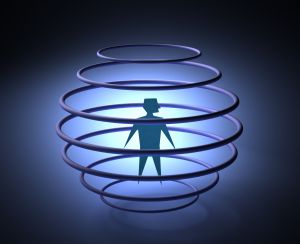Control of Consciousness
Control of consciousness determines the quality of life
— Csikszentmihalyi
Consciousness refers to the sensations, images, and thoughts that we experience and are able to influence. In contrast, dreaming includes some of the same experiences, but we are not conscious because we do not control them, they occur autonomously. Attention determines what will and what will not appear in consciousness. By purposely aiming your attention, you can influence the phenomena you experience.
The stimulus that captures your attention has the power to influence your state of consciousness. Addictive stimuli and threatening stimuli are typically the most salient stimuli around, and hence the most likely to capture your attention. You exercise your will when you over-ride the natural tendency to attend to the most salient stimulus, and instead purposely work with your attention. Each of the paths below offer a different approach to that objective.
Pathology and the study of paths
- Ecological methods [see below]
- Focused Attention Meditation
- Mindfulness
- Cognitive Therapy
- Intentional Trance Formation
- Suggestion
Addictive and Emotional Disorders are a consequence of a mismatch between the salience and the meaning of a stimulus. Trouble begins when a pathogenic stimulus captures your attention. The first, and probably best, line of defense is to keep your attention on stimuli that elicit resourceful and life-enhancing psychological states.
There are many competitors for your attention, but you can only fully attend to one thing at a time. Put another way, attention determines what will and will not appear in consciousness. Whatever captures your attention has a great impact on your state of consciousness. But attention has an opportunity cost. When you are focused on one thing, you are not attending* to other things.
The subjective reality you experience is determined by whatever captures your attention. You can exercise a mindful influence over your emotional state by purposely shifting your attention from stimuli that elicit counter-productive trances — such as anger, fear, or self-loathing — to stimuli that elicit more helpful subjective phenomena.
An Ecological Path
Before we get into the methods of controlling attention from within — the meditation exercises — I will describe the ecological approach to influencing your subjective experience: Engaging in flow activities.
Flow Activities
The motivation for engaging is some activities is the enjoyment of doing it. For me, skiing is a flow activity. They don't pay me to ski — quite the contrary! I do it because I like doing it. When I am skiing well, I am not thinking of past regrets and future threats, I am paying full attention to what I am doing in the here and now. With my consciousness so fully engaged in this demanding, yet enjoyable activity escape from destructive self-focused rumination is effortless.
Surprisingly, most of the benefits of Cognitive Behavior Therapy seems to be a consequence of getting people to engage in activities that involve pleasure and/or mastery [flow activities]. CBT is more effective than other approaches to treating depression because it is effective in getting people who do not feel like engaging in such activities to act.
Forms to help you along the Ecological Path:
Footnote:
* — It is possible to multi-task, but you can only attend to one thing at a time. Examples of multi-tasking, such as driving while having a conversation are possible because some tasks [driving in this case] have become autonomous and hence do not require attention, see Asleep at the Wheel.
